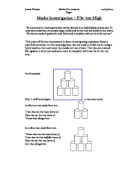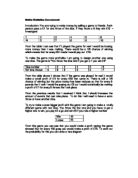+2 +3 +4 +5 …….line 2
1 1 1 …….line 3
The numbers on line 1 are the sequence of total number of tins in each stack and those on the second line are between the numbers in the sequence.
I have found a formula for this sequence using rules of quadratic sequences. I did this by:
1, 2, 3, 4, 5 (term number)
a+b+c = 1 3 6 10 15 …….line 1
3a+b = +2 +3 +4 +5 …….line 2
2a = 1 1 1 …….line 3
ax² + bx + c is the standard quadratic sequence and is used to find the formula
So…. 2a= 1
a= 0.5
3a+b = 2
1.5+b =2
b=o.5
a+b+c=1
0.5+0.5+c=1
c=0
So by substituting the answers into the formula on the previous page, I will get an overall formula for this investigation.
ax² + bx + c
0.5x² + 0.5x + c
Therefore the formula I have found is when x = The number of tin rows:
tn = ½x² + ½x
I will now test this formula to make sure it works in all stacks.
Firstly I will try two:
0.5 x 2² + 0.5 x 2
I calculated this sum and the answer was three. This was correct. I tried it again but with four;
0.5 x 4² + 0.5 x 4 = 4
This was also correct. This means that the formula for the brick bonding was correct and my prediction was correct.
I am now able to answer question one which is to find how many tins are in a stack of nineteen tins high.
0.5 x n² + 0.5 x n
0.5 x 19² + 0.5 x 19
= 190
Therefore there are 190 tins in a stack of 19 tins high.
Now I am going to investigate a different structure to see if the formula is the same for a four tin base that has a tin on top that touches all four other tins.
An Example :
I will find a sequence for the number of tins used and will then investigate a formula for a square based tin construction.
Term
Number= 1 2 3
Base= 1 4 9
I have recognised that there is a pattern for the number of tins on the base of a four based stack. There is a repetition of square numbers i.e.
1 x 1 = 1
2 x 2 = 4
3 x 3 = 9
Therefore the formula for the base is tn=n² but I am trying to investigate the number of tins in the whole structure.
I have found a sequence by using a practical and counting each tin in each stack.
Term Number 1, 2, 3, 4, 5
Total Number of Tins 1, 5, 14, 30, 55
Square Number Differences 4 9 16 25
(Base numbers)
These are odds numbers +5 +7 +9
missing numbers 1 and 3
Constant +2 +2
The reason why row four is tw0 is because the difference between odd numbers is always two. As we have to come down to a third line we are now in a cubic situation. I now have to use the cubic standard sequence t0 find the formula for the number of tins
Term Number 1, 2, 3, 4, 5
N= 1, 5, 14, 30, 55
a+b+c= 4 9 16 25
7a+3b+= +5 +7 +9
12a+2b= +2 +2
The standard cubic formula is an³ + bn² + cn + d
Therefore by substituting again, I can find the formula.
6a = 2
a =
12a + 2b + 5
4 + 2b = 5
b = ½
7a + 3b + c = 4
7 + 1 ½ + c = 4
c =
+ ½ + = 1
d = 0
Consequently the formula for a square based tin structure is….
tn = n³ + ½n² + n
n = Term Number
Further into my investigation, I will investigate a star based structure by adding on one more tin on to the end of each line every time. I will try and find a formula and test it to make sure it works. I will use a standard sequence rule and put numbers into it.
Firstly I will find a sequence to this structure that I am investigating. I will use the base numbers to as a starting point to investigating a formula
Term Number
1 2 3
Number of Tins on Base
1 5 9
Tins Added Each Time
1 6 15
I tested this in a practical situation and found that for term number four there were 28 tins altogether.
I will now use the numbers to make a sequence;
Term Number (N) = 1, 2, 3, 4
Added Tins 1, 6, 15, 28
Difference 5 9 13
Constant +4 +4
This shows that I will have to use the quadratic formula as there are three rows of working in the sequence above.
1, 2, 3, 4, (term number)
a+b+c = 1 6, 15, 28 …….line 1
3a+b = 5 9 13 …….line 2
2a = +4 +4 …….line 3
Therefore;
2a= 4
a= 2
3a+b = 5
6+b =5
b=-1
a+b+c=1
2-1+c=1
c=0
ax² + bx + c
2x² +– 1x which can be simplified into tn = n (2n – 1)
Therefore the formula for this star based structure is tn = n (2n – 1)
I will now test this formula to check that this formula works in all cases:
2(2x2 – 1)
= 6
This is correct
3(2x3 – 1)
= 15
This is also correct
This means that the formula that I have investigated is correct for this particular pattern, where x = the term number.
Conclusion
This graph shows all the patterns onto one graph. It shows that a star based structure uses more tin cans than a brick bond. They all have a positive relationship as all the lines move upwards. The star based structure and square based structure have the same amount of tins until about row four and then they start to split of and the square based tin stacks stack to decrease compared to the star based structure. A brick bond uses the smallest amount of tins overall.







